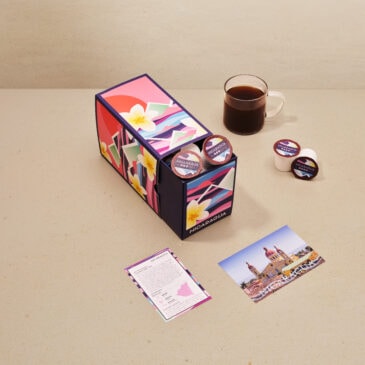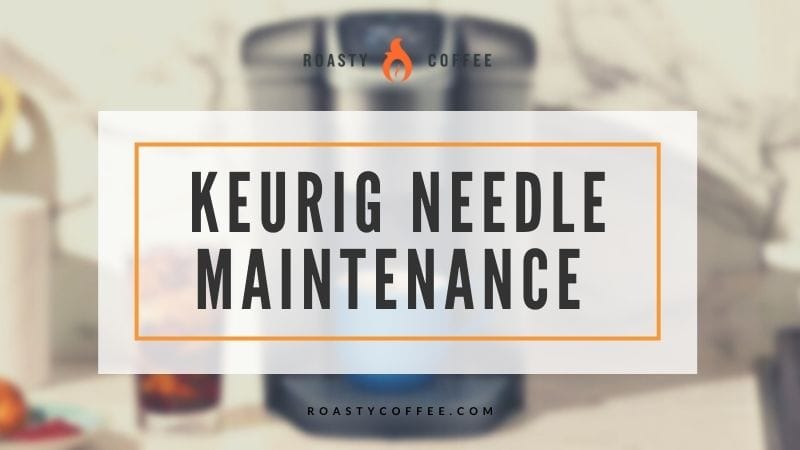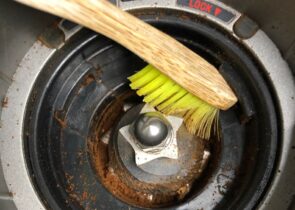If you’re one of 20 million households in the United States who owns a Keurig, you may be wondering why your machine no longer brews great-tasting coffee. You perform a monthly coffee machine cleaning, and you never let scale buildup, so what’s the issue?
That’s a real head-scratcher, but don’t worry! We’ve got you covered.

"The best coffee pod I've ever tasted"
Yes, we mean that. Finally, specialty coffee for your KCup machine, roasted fresh to your order by our friends at Atlas Coffee in Austin, TX! Get 50% OFF to try it with code ROASTYPODS
Like all coffee makers, the Keurig does need regular maintenance and cleaning to brew the java juice we all love. But one part of this popular coffee machine that’s often overlooked is the Keurig needle.
So let’s learn how to keep your Keurig kicking out cups of coffee.

What does the Keurig needle do?
The Keurig needles in the k-cup holder are a part of every k-cup compatible model of Keurig. Every machine has two: an entrance needle and an exit needle. These needles are placed on top and below the pod holder to puncture the coffee pod.
The hot water flow saturates the coffee grounds through the needle hole before finding its way to your coffee cup.
Most Keurig coffee machines have a sharp metal entrance needle and a blunt exit needle. The top needle punctures the top of the coffee pod, while the blunt bottom needle creates a stream of water coming out.
Importance of Keurig needle maintenance and cleaning
We all want the best performing coffee pod machine, so taking care of your Keurig is critical! Since the upper and exit needles are in daily contact with coffee grounds and warm water, they can get clogged.
Ground coffee will often stick to the puncture needle, eventually blocking the flow of fresh water. Without regular maintenance and cleaning, your hollow needle over time will become so clogged that it completely shuts down the fresh water flow.
How to Know When to Clean the Needle
Any of these issues might be signs you need a thorough Keurig needle cleaning.
- Less coffee in your coffee cup than you selected
- Slow-flowing coffee
- Strange noises but no coffee coming out
- A warning signal of too much water pressure
- Your coffee brewer is leaking – either before or after the brew cycle
- No longer the same great-tasting coffee you’re used to!
How to Clean the Needle
So what can you do if your single-use coffee machine is causing you problems? Fortunately, cleaning the needle is a straightforward process. But before you clean the needle, be sure to descale your coffee maker!
Cleaning the Needle with a Keurig Needle Cleaning Tool
Using the specialized needle cleaning tool is the simplest cleaning method.
What You’ll Need
- vinegar
- water
- a Keurig 2.0 cleaning tool
Step One
Unplug the machine from any power sources and remove your k-cup from the k-cup holder.
Step Two
Fill the maintenance accessory cleaning tool with water and vinegar, about a 2 to 1 ratio.
Step Three
Open the k-cup holder and place the brewer maintenance accessory tool inside.
Step Four
Open and close the brew head several times. If you have visible buildup, more is better!
Step Five
Remove the cleaning tool and run about three clean water cycles to remove any residual coffee grounds and debris.
Cleaning the Needle without the Brewer Maintenance Accessory Tool
No special tool? No problem! You can still keep your needles clean and delicious coffee drinks brewing. This alternative process takes a few extra steps, but it’s worth it.
What You’ll Need
- vinegar
- water
- a regular paper clip or safety pin
Step One
Start by unplugging your machine and removing the pod holder.
Step Two
Detach the bottom funnel from the pod holder and soak the k-cup holder in a plain water and vinegar solution for a least five minutes.
Step Three – Cleaning the Bottom Needle
Pick at the Keurig nozzle using the paper clip while rinsing it under tap water. This alternate method will loosen and remove any debris and stuck grounds.
Step Four – Cleaning the Top Needle
Lift the brew head lever to access the sharp top needle. Using the paperclip method, carefully pick the coffee grounds and gunk. Careful, it’s sharp!
Step Five
Re-attach the funnel and place the k-cup holder back in the brew head. Run three rinse cycles to clean out any loose coffee grounds.
Frequently Asked Questions
How often should I clean the needle?
How often you clean depends on how often you use your Keurig machine. If you’re like us, you might brew multiple cups a day. In that case, you’ll want to clean the needles every couple of weeks. If you haven’t already, you may want to invest in the K-cup cleaning tool.
But if you only use your Keurig now and again, you can probably clean it about once a month.
How often should I descale my machine?
Once again, this also depends on how often you use your machine. Descaling removes all the buildup of calcium that clogs your machine and slows it down. We suggest cleaning it about every three to six months. Regular descaling will help improve every cup of coffee.
How often should I clean my machine?
Cleaning is different than descaling, and it targets the coffee oils that sometimes build up in the water reservoir. We recommend using the disposable rinse pods about once a month to keep your machine serving up delicious, clean coffee.
What if it still doesn’t work?
Sometimes a needle can become damaged or misaligned, and it needs to be replaced. You’ll want to purchase a puncture needle replacement and follow the steps in your Keurig manual.
Wrap Up
Investing time and effort into K-cup Keurig needle maintenance will solve many of your morning coffee issues. Proper coffee machine maintenance will improve your morning coffee brewing ritual, solving problems ranging from a slow-filing coffee mug to an interruption in the flow of coffee filtering through the machine.
Happy Caffeinating!







